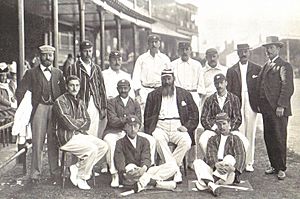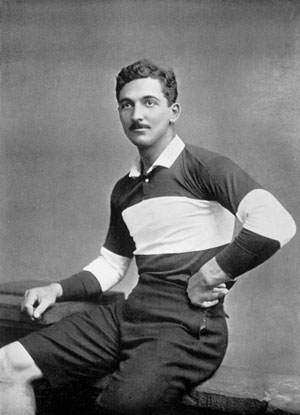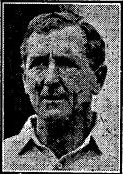C. B. Fry facts for kids
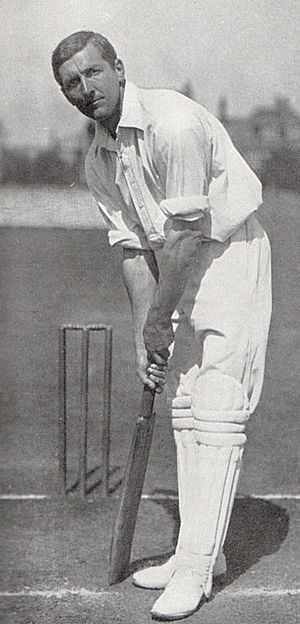 |
||||||||||||||||||||||||||||||||||||||||
| Personal information | ||||||||||||||||||||||||||||||||||||||||
|---|---|---|---|---|---|---|---|---|---|---|---|---|---|---|---|---|---|---|---|---|---|---|---|---|---|---|---|---|---|---|---|---|---|---|---|---|---|---|---|---|
| Full name |
Charles Burgess Fry
|
|||||||||||||||||||||||||||||||||||||||
| Born | 25 April 1872 Croydon, England |
|||||||||||||||||||||||||||||||||||||||
| Died | 7 September 1956 (aged 84) Hampstead, London, England |
|||||||||||||||||||||||||||||||||||||||
| Batting | Right-handed | |||||||||||||||||||||||||||||||||||||||
| Bowling | Right-arm fast-medium | |||||||||||||||||||||||||||||||||||||||
| Relations | Beatrice Holme Sumner (wife) Stephen Fry (son) |
|||||||||||||||||||||||||||||||||||||||
| International information | ||||||||||||||||||||||||||||||||||||||||
| National side | ||||||||||||||||||||||||||||||||||||||||
| Test debut (cap 95) | 13 February 1896 v South Africa | |||||||||||||||||||||||||||||||||||||||
| Last Test | 22 August 1912 v Australia | |||||||||||||||||||||||||||||||||||||||
| Domestic team information | ||||||||||||||||||||||||||||||||||||||||
| Years | Team | |||||||||||||||||||||||||||||||||||||||
| 1892–1895 | Oxford University | |||||||||||||||||||||||||||||||||||||||
| 1900–1902 | London County | |||||||||||||||||||||||||||||||||||||||
| 1894–1908 | Sussex | |||||||||||||||||||||||||||||||||||||||
| 1909–1921 | Hampshire | |||||||||||||||||||||||||||||||||||||||
| 1921/22 | Europeans (India) | |||||||||||||||||||||||||||||||||||||||
| Career statistics | ||||||||||||||||||||||||||||||||||||||||
|
||||||||||||||||||||||||||||||||||||||||
|
Source: CricInfo, 12 November 2008
|
||||||||||||||||||||||||||||||||||||||||
Charles Burgess Fry (born April 25, 1872 – died September 7, 1956) was an amazing English sportsman. He was also a teacher, writer, and publisher. People remember him most for his incredible cricket career.
Many called him "the most gifted Englishman of any age." Fry played for England in both cricket and football. He even played in an FA Cup Final for Southampton F.C.. He also tied the world record for the long jump. There's a famous story that he even turned down the chance to become the King of Albania! Even when he was in his seventies, he could still do a cool party trick: jumping backwards from a standing position onto a mantelpiece.
Contents
Early Life and Education
C. B. Fry was born in Croydon, England. His father worked for the government. Fry won a scholarship to attend Repton School. Later, he went to Wadham College, Oxford. He was very good at subjects like Latin and Greek. At Repton, he won many awards for his writing in these languages.
Fry was also a talented athlete from a young age. He played for Repton's under-16 football team when he was just thirteen. He became captain of both the school's cricket and football teams. He also won prizes for athletics. At sixteen, he played in the F.A. Cup for a team called the Casuals.
At Oxford, Fry continued his sporting success. He earned a "Blue" (a special award for top athletes) in football, cricket, and athletics. He almost got one in rugby too, but an injury stopped him. During his time at Oxford, he met famous people like the writer Max Beerbohm.
In 1894, when Fry was only 21, a magazine called Vanity Fair featured a cartoon of him. They even joked that he should be called 'Charles III' because he was so impressive!
Towards the end of his time at Oxford, Fry faced some tough challenges. He had a lot of stress, which affected his health. Despite this, he managed to take his final exams. He finished his university studies in 1895.
Family Life
In 1898, Fry married Beatrice Holme Sumner. She was ten years older than him. They had three children together. Their son, Stephen, also played first-class cricket.
Sporting Achievements
Besides his main sports, Fry was also good at other activities. He was a decent shot putter and hammer thrower. He even enjoyed ice skating and was a skilled golfer.
Cricket Career
Fry played cricket for several important teams. He played for Oxford University from 1892 to 1895. He captained the university team in 1894. This meant he was captain of both the university cricket and football teams, and president of the athletics club all at once! He also played for Sussex (1894–1908) and Hampshire (1909–1921).
He first played for England in 1895–96 in South Africa. He later captained England in his last six Test matches in 1912. He won four of those matches and drew two. He scored two Test centuries (over 100 runs in one innings). He scored 144 runs against Australia in 1905 and 129 runs against South Africa in 1907.
Fry was a very good right-handed batsman. He usually batted at the top of the batting order. He scored an amazing 30,886 first-class runs. His average was 50.22 runs per innings. This was very high for his time. He was the second-best retired player in terms of batting average. Only his friend Ranjitsinhji had a better average. Fry was the top batsman in England for six seasons (1901, 1903, 1905, 1907, 1911, and 1912).
Early in his career, Fry was also a good fast-medium bowler. He took 6 wickets for 78 runs in a university match in 1895. He also took ten wickets in a match twice. However, his bowling action was sometimes questioned.
In 1901, Fry achieved something amazing: he scored six centuries in a row! No other player has done this in first-class cricket. His highest score was 258 not out in 1911. This great performance led to him being called back to captain the England Test team in 1912.
Fry later became a cricket commentator. People called him "one of the most eloquent cricket commentators of all time." He was good friends with Prince Ranjitsinhji. They played together for Sussex and England. Their different batting styles worked well together. Fry was very traditional, while Ranji was known for his new ideas. Their friendship lasted for many years.
Athletics Achievements
Fry was also an outstanding athlete. He earned "Blues" in all four years at Oxford (1892–95). He represented the university in the long jump, high jump, and 100 yards race.
In 1892, Fry broke the British long jump record. He jumped 23 feet 5 inches (7.14 meters). A year later, on March 4, 1893, he tied the world long jump record. He jumped 23 feet 6.5 inches (7.17 meters). This record was later broken in 1894.
In 1894, Oxford competed against Yale University from the USA. Fry came third in the long jump and won the 100 yards race. He was also good at hurdling. In 1894, he was the president of the Oxford University athletics club.
Football Career
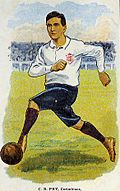 |
|||
| Personal information | |||
|---|---|---|---|
| Height | 5 ft 10 in (1.78 m) | ||
| Position(s) | Full-back | ||
| Senior career* | |||
| Years | Team | Apps | (Gls) |
| 1891–1903 | Corinthian | ||
| 1900–1902 | Southampton | 16 | (0) |
| 1902–1903 | Portsmouth | 2 | (0) |
| International career | |||
| 1901 | England | 1 | (0) |
| *Club domestic league appearances and goals | |||
Fry was also a talented football player. He was a fast defender. He learned to play at Repton School, where he captained the team. He also played for the amateur club the Casuals at age sixteen.
At Oxford University, he earned "Blues" in all four years. He captained the team in his third year. In 1891, he joined another famous amateur club, the Corinthians. He played 74 games for them and scored four goals.
Even though he was an amateur, Fry wanted to play for England. He joined Southampton F.C. in 1900. They were a top team in the Southern Football League. He helped them win the Southern League title in the 1900–01 season.
On March 9, 1901, Fry played for the England against Ireland. This was his goal to play internationally. The next season (1901–02), Southampton reached the FA Cup Final. They drew 1–1 with Sheffield United F.C., but lost the replay 2–1. Fry played in all eight FA Cup games that season. He made 25 appearances for Southampton.
After Southampton, he joined Portsmouth F.C. in 1903. He played three games for them before retiring from football due to an injury.
Rugby Union
Fry also played rugby union. He played for Oxford University. He almost earned a "Blue" in his final year but was injured. He also played for Blackheath F.C. and the Barbarians. He was even chosen as a reserve player for a big match that was like an England trial.
Acrobatics
Fry had a famous party trick. He would leap backwards from a standing position on the floor onto a mantelpiece. He would face the mantelpiece, crouch down, jump up, turn in the air, and land with his feet on the shelf. He would then bow to the audience.
Life Outside Sport
Teaching and Nautical School
In 1896, Fry became a teacher at Charterhouse. Two years later, he left teaching to become a journalist. He found that journalism paid much better and took less time.
In 1908, he became the Captain Superintendent of the Training Ship Mercury. This was a special school that prepared boys for service in the Royal Navy. His wife, Beatrice, had founded the school. Fry held this position until 1950. He was given the rank of captain in the Royal Naval Reserve (RNR).
Political Interests
Fry was interested in politics from his time at Oxford. In 1920, his friend Ranjitsinhji became one of India's representatives at the League of Nations in Geneva. Fry went with him as his assistant.
While working there, Fry claimed he was offered the throne of Albania. It's not fully clear if this offer was serious, but he was definitely considered a possible candidate for the job.
Fry also tried to become a Member of Parliament for the Liberal party. He ran for election in Brighton in 1922, but he did not win. He also ran in Banbury in 1923 and Oxford in 1924, but was unsuccessful.
Writing and Broadcasting
Fry wrote many books, mostly about cricket. Some of his books include:
- The Book of Cricket: A New Gallery of Famous Players (1899)
- Great Batsmen: Their Methods at a Glance (1905)
- Great Bowlers and Fielders: Their Methods at a Glance (1907)
- Life Worth Living: Some Phases Of An Englishman (1939), his autobiography.
He also wrote for magazines like The Strand Magazine. In the 1930s, he wrote a column for the London Evening Standard newspaper. This column covered many different topics and helped the newspaper sell more copies. He even started and edited his own magazine, C. B. Fry's Magazine.
Fry also had a career in broadcasting. He started commenting on cricket matches for the BBC in 1936. In 1945, he joined a popular radio show called The Brains Trust. In 1955, he was featured on the TV show This Is Your Life. Famous cricketers like Jack Hobbs and Sydney Barnes were there to celebrate his life.
Later Years
In the 1920s, Fry faced some health challenges. He had experienced similar issues during his time at Oxford. He recovered and continued to be a popular writer on sports. Even in his sixties, he hoped to become a Hollywood movie star.
In 1934, Fry visited Germany. He wanted to create stronger connections between British youth groups, like the Boy Scouts, and the Hitler Youth. He met Adolf Hitler and exchanged salutes. He tried to convince German officials to take up cricket. Some members of the Hitler Youth even visited the TS Mercury school.
Fry retired from his role at TS Mercury in 1950. He passed away in 1956 in Hampstead, London. His ashes were buried in the churchyard of Repton Parish Church. His gravestone reads: "1872 C B Fry 1956. Cricketer, scholar, athlete, Author – The Ultimate All-rounder."
Honours
Southampton F.C.
- FA Cup finalist: 1902
Two buses in Brighton were named "C B Fry" in his honor.
See also
- List of English cricket and football players
- List of cricket and rugby union players
Images for kids


